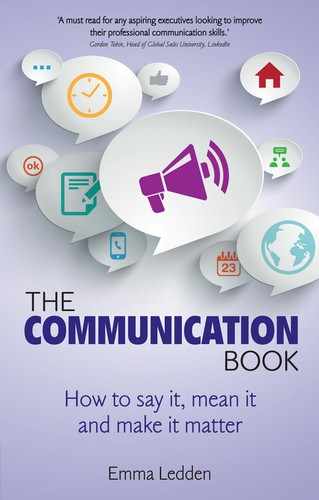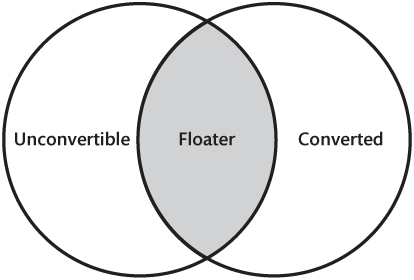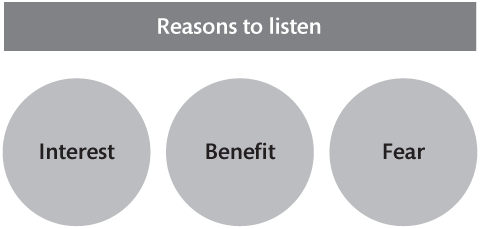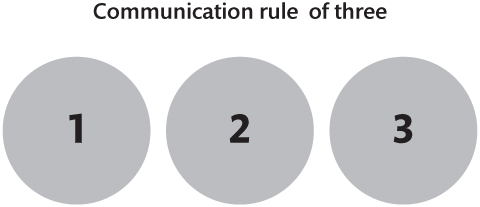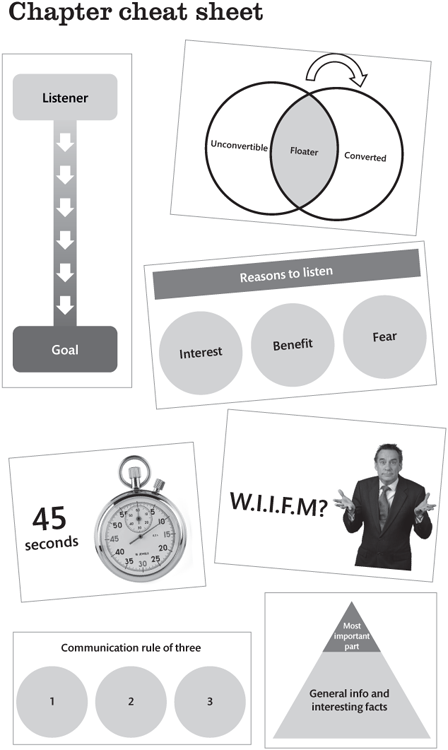STEP 1
Know the purpose
What is your communication goal?
Every interaction you have is going to be different, but your best chance of success is to understand the vital part you play in your communication. You can’t just talk, focus only on your own agenda, have no clear point and expect the listener to do all the work.
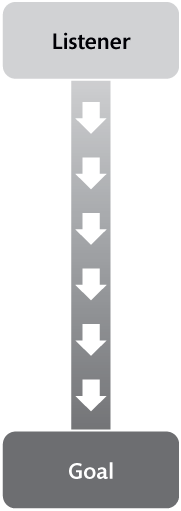
The first step to being a great communicator is to take responsibility for the experience you are creating when you speak. To be a great communicator you must do three things:
- Engage the listener: tell them why they should listen.
- Take the listener through your information in the most relevant, understandable and enjoyable way: yes, I do mean enjoyable.
- Ensure you achieve your communication goal: you must have a communication goal.
We communicate every single day to:
- give information;
- express our emotions;
- provide advice;
- deliver feedback;
- sell our product or service;
- influence;
- motivate;
- educate.
Too often, the communication doesn’t achieve its goal and fails. More often than not, we open our mouths and words come tumbling out. The right words, the wrong words and everything in between. Words we hadn’t planned, words we didn’t mean and sometimes words we wish we could take back.

We open our mouth and we talk. And it is the talking that gets us into trouble.
The trouble with talking
Words have a great power. Every time you speak you have the potential to build or un-build a relationship.
It is for this reason you need to:
- plan your words;
- place your words in the right order;
- make sure the words you are speaking are relevant and understandable to the listener.
You also need to plan to pause, plan to listen and plan what questions you will ask.
Finally, you need to plan for the unexpected – plan to manage your emotion and plan for the worst-case scenario.
Phew! That is a lot of planning, I know. I love planning (seriously, I do), but I realise this is not a universal feeling so let me change the word ‘plan’ for you in the hope of making this as easy as possible.
Think. You simply need to think before you talk. That’s it.
Most people’s approach to verbal communication is to talk without thinking. You must change this fundamental approach if it is yours. You must stop and think before you speak.
You must move from simply speaking in a freestyle manner, with no consideration for your words or their impact, and begin to prepare your communication, your everyday business interactions, in a listener-focused way.
What does this look like?
The talking approach to communication happens when the speaker:
- does not take the time to understand the listener and how to connect with them;
- does not prepare clear messages;
- assumes the listener is listening and understands;
- talks when it is too late or at the wrong time;
- is not prepared to manage difficult conversations.
Listener-focused communication happens when the speaker:
- understands the listener: they find out how much or how little the listener knows or understands about the message or interaction before it happens and they start from there;
- knows what they want to say: the speaker identifies the central point or points they want to communicate;
- has a clear structure and has their points in the right order;
- is prepared to deal with questions and accepts people will need to ask questions to clarify for themselves what they understand;
- is saying the right words, in the right way, at the right time.
It is your communication. You must own it. Be clear on the purpose, the point and the path before you speak.
‘Handle words with care. They may damage you as well as others.’
TASNEEM HAMEED
STEP 2
Know your listener
Great communication is an active process that involves engagement, energy and movement.
The purpose of great communication is to get your listener from one point to another in the best possible way. To do this you must:
- engage the listener;
- take the listener through your information in the most relevant, understandable and enjoyable way;
- ensure you achieve your communication goal.
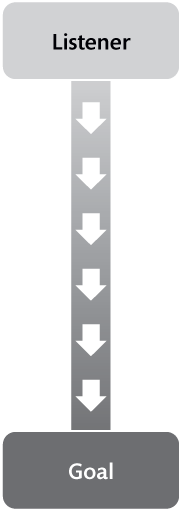
To achieve this you must consider your listener and how you are going to connect with them.
You can do this in three ways:
- profiling them;
- making sure they are floating;
- giving them a reason to listen.
Stage 1: profile your listener
One of my favourite shows on television at the moment is called Criminal Minds. It is about a special team of FBI profilers who analyse criminals to determine their next move so that they can catch them.
They begin by understanding all they can about the criminal. They look at their past behaviour, emotions and circumstances to figure out how they will behave in the future. They gather as much information as they can about the criminal. This is the art of profiling someone.
Profiling is about understanding someone, how they think and what is important to them. To be a great communicator you must profile your listener before you speak.
You must gain an understanding of where they are coming from, what your communication will mean to them and how they might react to it, before you speak.
Profiling is about getting into someone’s head, standing in their shoes and understanding where your listener is at before you speak.
Stage 2: make sure they are floating
Your listeners will always fall into one of three categories:
- the converted;
- the unconvertible;
- the floater.
The converted
This is someone who is already doing, thinking or feeling the things you want them to before you speak.
The converted may feature in business scenarios like these:
- A fellow team member is at a meeting where you are giving an update on the progress of the project. They are in the room during the meeting but they are not the person/people you are trying to communicate with as they already know the project status, because they work on the project with you.
- You might be going for a job interview and your manager is one member of the interview panel. Your manager knows you and your work and may have decided you are the right person for the job before the interview. This person is the converted, so there is no persuasion necessary.
- You may be at a networking event and a friend introduces you to a new connection and you begin discussing what you do for a living. This information is given to educate your new acquaintance. Your friend knows what you do and is, as such, the converted in this scenario.
The converted may be present when you communicate but they are not your primary listener.
The unconvertible
When your listener is in this position they can’t be converted.
‘We were on a break!’
As well as Criminal Minds, I also watch re-runs of Friends on TV. If you do too you will know Ross and Rachel and their on-again/off-again relationship in the sitcom.
On one of their most memorable breaks, Ross went off with another woman. Rachel saw this as a betrayal because they only broke up for one night. Ross maintained they were ‘on a break’ and he did not betray her.
This was to become a recurring fight as, despite Rachel trying to convince Ross otherwise, he stood firm right to the end that he did nothing wrong as they were ‘on a break’.
Ross is an example of the unconvertible (as is Rachel). No matter what anyone said, they both held their positions.
If we look at our business scenarios from the unconvertible position, this is what they look like:
- Work colleagues are at a department meeting where you are giving a project update. They work on a totally different project and your information has no impact or relevance to them. There is simply no reason for them to listen and they are not interested. They are in the room but not listening.
- You go for a job interview and a member of the interview panel believes another candidate of their choosing is more suitable for the job. They may ask you questions and listen to your answers, but for this individual, rightly or wrongly, their mind is made up so persuasion is impossible.
- You may be at a networking event and a friend introduces you to a new connection. This person has no interest in you. Maybe they are a bad networker, maybe they are just there to sell their service or maybe they don’t care. Whatever the reason, you will never get to convert this new person as they are not open to the communication.
You will come across unconvertibles in your work life. The usual reason they are unconvertible is because your information has no impact on them whatsoever at that time.
The key message I want to deliver to you on this is: when someone is in this unconvertible position in relation to your communication, it means they cannot be converted at this time on this topic.
You may still deliver your messages and give them your information. They may listen and understand, yet still not do what you hoped. They may not listen to you at all.
You can give your information to an unconvertible but you can’t expect them to convert.
The floater
The floaters are the group open to being communicated with, and your aim is to turn them into the converted.
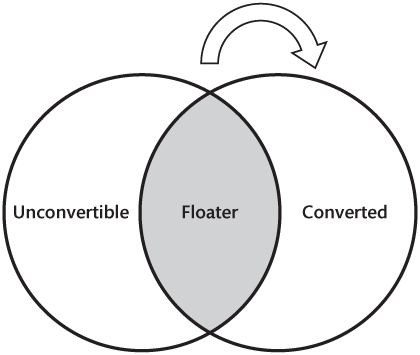
A floater will listen to you. A floater will engage with you. A floater can be converted, convinced and changed.
But… there is a ‘but’.
You still have to do the work to make the movement from floater to converted happen. You must figure out why the person is still floating and what information they need to be converted.
Let’s look at our scenarios one more time:
- You are at a department meeting giving an update and this update needs to be understood and actioned on by some people in the room. Your information has a huge impact on them but they do not know this. To move them from floater to converted you need to get their attention and let them know this status update is relevant for them.
- You are going for a job interview and there are some panel members who have no favoured candidate and will choose the person who communicates successfully. To convert these floaters you must prove you are the right person for the job.
- You are networking and meeting people who are interested in making connections. They are open to learning about you. To convert them you must tell them a little about what you do in this first meeting, keeping in mind your only purpose at this stage is to get a second meeting. Turning a floater to a converted is getting another meeting in this scenario.
To convert your floater you must give them more information or explain to them what they don’t understand. You must figure out what questions they have about your topic, before you speak, and you must answer them as simply and clearly as possible.
Stage 3: give your listener a reason to listen
Any listener you ever find yourself in front of will listen to you for three reasons only:
- They are sincerely interested in what you have to say.
- They will gain something of value or they will benefit if they listen.
- They fear they will lose something of value or there will be a negative consequence for them if they don’t listen.
Probably the biggest mistake I see made by the people I work with is that they speak assuming they have the interest of the listener.
They guess, often wrongly, that the listener knows the relevance and importance of the information to be communicated. They assume the listener is genuinely interested. They protest that the listener should be interested.
Maybe the listener will listen, maybe they won’t. Maybe they should, maybe they shouldn’t. Maybe they know the importance of the message, maybe they don’t. The truth is, you really have no idea or control if you rely on interest alone. So don’t.
Don’t place the burden on the listener to listen. Instead place it on you, the speaker, to give the reason to listen.
Your listener will only listen to you if there is a reason for them to listen.
If that is not genuine interest on their part, you, the speaker, must provide the reason to listen in the form of a benefit (gain) or negative consequence (loss) if the listener doesn’t listen.
When you are about to communicate in any situation, the person you are talking to has two simple questions in their mind:
- How long will this last for?
- What’s in it for me?
In other words… Why should I listen?
Hooking your listener in
Listeners decide if something is worth listening to very quickly: they decide if they care about your communication in the first 45 seconds.

You must tell you listener clearly and simply in the first 45 seconds why they should listen to you. You must tell them why your information is of value to them or tell them the gain or the loss for them. You must do this in the first 45 seconds of your communication so you can hook them into the conversation.
Communicating the wrong way around
Many people do not prepare for their day-to-day interactions. As a result they speak off the cuff. Talking off the cuff can lead to a style of communication where you give a lot of background information and general facts before you actually get to the point you are making. By many listeners this is judged as waffling or rambling. Some, and I mean some, of this background information may be helpful or relevant but it is probably still in the wrong place.
The theoretical term for giving background information and reversing your way into your key point is deductive reasoning.
This means talking from the general to the more specific:
- beginning with general information and background;
- covering all possible areas related to the topic and going off on tangents;
- finally, right at the end, if the speaker has not confused themselves or everyone else, they will actually get to the point of the communication.
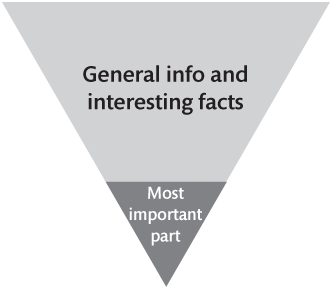
Deductive reasoning is a very legitimate approach to communication, but you really must ask yourself if your listener is going to wait until the end to get what they need. Would you wait?
I believe the answer is sometimes. Sometimes you will have a listener who does not mind this approach and is happy or willing to listen to the detailed background. I also believe there are many listeners who just want you to get to the point and get to the point fast. There are many who feel their precious time is being wasted when you use this approach. There are also many listeners who don’t even know why they should be listening to you in the first place. For this reason it is essential to hook them in at the beginning by telling them the relevance and value of your information before you go into detail.
If you wish to engage a listener and get their attention, you need to turn the triangle the right way around.
Turn it the right side up
This is what is called inductive reasoning. Inductive reasoning moves from the specific to the more general yet relevant material. You must start with your most relevant and engaging point for your listener at the beginning. You can then go into detail explaining your point and backing it up for your listener.
This way the listener knows why they are listening and what’s in it for them from the start.

This is a great start. This is the right start.
Now you have their attention.
Now you have a chance.
Empathy – the essential element
We see the world not as it is but as it is for us. Our view of the world can be as unique as our finger print.
We can only see the world from the part of the window we are looking out from and this can be different for all of us. A vital element of great communication is to try and see the world through someone else’s part of the window, as well as our own.
Why?
Because communication, at its very core, by its very definition, is about creating understanding and being understood. In order to do this we must be able to empathise. We must work to see with another’s eyes, hear with another’s ears and feel with another’s heart.
EMPATHY
This is the ability to understand what others might be feeling and thinking. It is the ability to view the world through another person’s eyes.
If you behave in an empathetic way towards someone, what you are doing is validating them. It says to another person that you have heard what they said, you see them and understand their viewpoint.
When you fail to empathise, you are failing to validate another person’s view from their window.
This means you are actually rejecting the person you are speaking to. Not empathising when someone speaks is like putting your hand over their mouth when they are talking. Real connection is therefore impossible.
‘Empathy fuels connection. Sympathy drives disconnection.’
DR BRENE BROWN
Empathising does not mean you agree or disagree. It simply means you see, hear, feel and understand how it is for someone else.
EMPATHY IS NOT THE SAME AS SYMPATHY
Sympathy is feeling for: sympathy and empathy are both acts of feeling, but with sympathy you feel for the person – you’re sorry for them or pity them, but you don’t specifically understand what they’re feeling.
Empathy is feeling with: empathy is feeling with the person. It means you have a good sense of what they feel and you understand their feelings as far as is possible.
Sympathy is acknowledging there is another part of the window that someone might look through, but empathy is actually being able to see the world through that window pane.
One of the ways you can display empathy is through active listening, which we will explore in our next section.
STEP 3
Prepare to speak
Our everyday interactions involve three elements:
- Speaking
- Questioning
- Listening
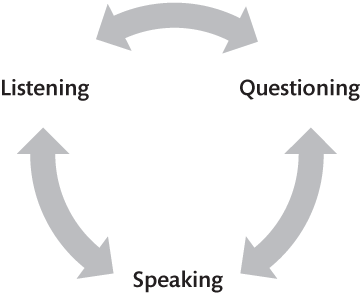
These three elements are woven together inextricably to make up our daily conversations.
I would like to take each element and give you some insight into the skills of speaking, questioning and listening.
Speaking
Speaking is the part where you have something to say – a message to deliver or a story to tell.
Most people I work with tell me they are not good at delivering a point or message, because they:
- waffle;
- can’t get to the point;
- are not clear themselves what they are talking about.
The truth is, too often this self-diagnosis is correct. I continually meet individuals who make the mistakes listed above.
The good news is, there is a very simple reason why they can’t deliver a clear point or message: they are not preparing a clear point before they speak.
I am going to repeat that again as it is very important.
You can’t deliver a clear point if you haven’t prepared one… and preparing in your head doesn’t count.
Mulling it over in your head, believing you know what you are going to say in your mind, will never materialise into clear, concise spoken communication. There are many different ways to say things, and that is why the words you speak may be different to how you planned to speak in your head.
‘Everything becomes a little different as soon as it is spoken out loud.’
HERMANN HESSE
If you don’t prepare relevant and structured verbal communication, you will end up subjecting your listener to what I call the ‘all you can speak buffet’ . Have you been to a restaurant or event where a buffet meal was served?
It’s where there is every possible variety of food available and you must go with your plate and pick the food you want and leave the food you don’t want.
In communication terms, the ‘all you can speak buffet’ is giving lots of information when you speak (some relevant and some not so relevant) and expecting your listener to pick and choose what points they want and what points they don’t.
You are expecting your listener to pick and choose from all the information you are offering.
The ‘all you can speak buffet’ involves a lot of work on the part of your listener to sort through your words.
The question: Is your listener willing to work that hard?
I don’t believe they are. They want you to do the work for them. They want you to serve them up tailored, relevant messages.
What if, instead of the ‘all you can speak buffet’, you treated your listener to ‘Michelin-star communication’?
A Michelin star is awarded to select restaurants globally, based on the excellent overall experience they deliver to their customers. Michelin-star restaurants serve the finest food, in bite-size portions, that flow from one course to another creating a pleasurable overall experience.
I want you to start preparing Michelin-star communication, where you:
- pre-select and tailor your information based on the listener’s needs;
- deliver your points clearly;
- do all the work and allow your listener to sit and enjoy the experience.
You can do this by following the ‘communication rule of three’.
In order to give your listener clear points and tailored information you will need to decide what your key points are before you speak. If you have lots of information, you will need to organise or package this information into groups so that your information is digestible and memorable for the listener. One of the most effective ways to do this is by following the ‘communication rule of three’.
The ‘communication rule of three’ is a very general rule in speaking, writing and music that says ideas presented in threes are inherently more interesting, more understandable and more memorable.
Stories have a beginning, middle and end. Many movies and books are works of trilogy.
There are many famous speeches and taglines that follow this rule, for example: ‘Work, rest and play’, ‘Life, liberty and the pursuit of happiness’, ‘Stop, look and listen’.
In order to give your audience Michelin-star communication you must examine your information and ask yourself, what are my three key points?. If you have a lot of information to deliver, you must group all this information into three key areas – like a story with a beginning, middle and end section.
Questioning
Questions are a vital part of our communication tool kit. We ask questions to:
- get information;
- clarify;
- understand an issue;
- show interest;
- build rapport.
There are four main question types you need to be most aware of:
- Open questions.
- Probing questions.
- Mirroring questions.
- Closed questions.
Open questions
These questions get you started. They are general, information-gathering questions to which there is no right or wrong answer.
These questions usually begin with the words ‘what’, ‘where’, ‘why’ or ‘how’. For example:
- ‘Where do you see solutions…?’
- ‘What do you think of the idea…?’
- ‘Which is the best way to tackle the problem of…?’
These are the best types of questions for getting a conversation started. They are thought-provoking and elicit a variety of possible answers. These questions are used to start a discussion and to get the ball rolling.
Probing questions
These questions pick up on the main issues (usually from a response to the open question) and move the discussion further along. They are the ‘tell me more’ questions. They allow an issue to be probed into in more detail. You ask the person to tell you more about the issue.
Mirroring questions
These types of questions check for understanding, as the issue is being discussed in detail. A mirroring question uses the other person’s words to confirm that they really meant what they said.
Closed questions
These questions always produce a ‘Yes’ or ‘No’ answer. They are very useful in summing up and confirming actions at the end of an interaction.
The funnel effect
Good questioning is about using these four question types to get to and gain a proper understanding of the underlying information, the real need or the heart of an issue.

There are three steps involved in ‘the funnel effect’:
- Open questions: Always start with open questions about the subject. This will give you all the information you need to take the conversation further.
- Probing and mirroring questions: This stage of the questioning will allow you to delve deeper into the listener’s answers, finding out the reasons and emotions behind those answers.
- Closed questions: Asking closed questions allows you to confirm both your and the other person’s understanding of what has been discussed. It will also show the listener you have been listening.
THE FUNNEL IN ACTION
Let’s look at an example of the funnel effect in action.
Louise just went in to see her boss, Alan, to ask for two weeks off work. Let’s see how she got on:
Open question
‘What happened with Alan when you went into his office to ask for two weeks off?’
Probing questions
‘What is the first thing you said to him?’
‘How did he react?’
‘Were you surprised by his reaction?’
Mirroring question
‘You felt very shocked and a little disappointed about his refusal to give you the time off?’
Closed question
‘So you don’t have the full two weeks off, but he has agreed to give you a week off?’
A question of quality
You have no control over how someone responds to your questions, but there are things you can do to help the questioning process run more smoothly.
- Prepare each question before you ask it. Do not develop the question while you are asking it.
- Make your questions as concise as possible.
- Do not ramble, go off on a tangent or give irrelevant information in the middle of your question.
- Ask only one question at a time.
- Avoid asking multiple choice questions, such as ‘When you were travelling to work today did you take the train, the bus or a taxi?’. Just ask, ‘How did you travel to work today?’.
- Phrase questions simply, using everyday language.
- Maintain eye contact with your listener while asking questions and listening to responses.
- Ask your question then stop talking and wait for the answer. You need to allow a reasonable amount of time for your listener to consider the question and come up with their answer. A common mistake we all make is to expect an immediate reply. When it doesn’t come we jump in too quickly with another question.
Silence is golden
You need to try hard to develop the ability to ask a good concise question, and then keep quiet.
If you are feeling nervous or impatient then a short silence can feel like an eternity, but if you fill silences too quickly you will seriously damage your ability to have good conversations.
It may help to visualise your question as a ball that you have thrown to the other person. When you have thrown the ball by asking a good, clear question, be silent. Don’t say anything else until they have answered your question and thrown the ball back.

And if you are the one being asked the questions:
- Listen carefully to the whole question. People sometimes have a tendency to think they know the question and they stop listening before it has been asked in full. The completed question can be very different from what you predicted.
- Show respect to the person asking the question by looking at him or her and paying attention.
- Never show signs of impatience or interrupt anyone, even if they are asking a rambling or wordy question.
- Nod your head agreeably from time to time to encourage the person who may be having difficulty asking their question or being clear.
Listening
I have to admit something to you. I am an interrupter.
Sometimes I do it because I am too impatient to wait for the other person to get their entire answer out. Sometimes I interrupt because I think I know what the other person is going to say (because I am clairvoyant, you know). Most of the time I do it because something the other person said has triggered something in my head that I have to say straight away or I will burst!
Barriers to listening
Our daily working lives contain a bombardment of information from multiple sources and an uncountable number of distractions within and beyond our control. It can be very hard to be a good listener while battling the tsunami of daily data we face.
Some of the biggest barriers to being a good listener are:
- our beliefs and attitudes;
- a lack of interest;
- distractions.
Types of listening
There are three main ways you can listen in your everyday interactions;
- Passive listening: You are there physically, making eye contact but offering little or no feedback – verbal or non-verbal. This can result in the other person feeling you are not interested in the conversation.
- Selective listening: This is where you will ‘tune out’ of bits of the conversation. You will look disinterested, be easily distracted or will jump in to change the subject at the earliest opportunity. This can result in the other person feeling you have more interesting things going on elsewhere.

- Active listening: There are no shortcuts to becoming a great listener, and the price tag for poor listening is high. Listening well can cut down on misunderstandings, missed opportunities and disagreements. Listening well will build strong unions, increase knowledge and deliver better results.
Both of the first two listening styles can have a negative impact on your objectives of building and deepening relationships with your colleagues and clients. You need to be self-aware and try to not let yourself slip into these modes. To show interest, empathise and build good relationships you must listen actively.
Real listening is an active not passive process. You have to choose to give your undivided attention.
How to become an active listener:
- Be present:
- Give your full attention to the speaker.
- Don’t interact with your phone while someone is talking to you.
- If you can’t give your full attention, reschedule.
- Wait your turn:
- Don’t talk before the speaker has finished.
- Recognise how impolite it is to interrupt the speaker.
- Listen non-verbally:
- Be aware of body language – both your own and the person you are speaking to. Face the speaker fully and maintain good eye contact.
- Use verbal and non-verbal signals to confirm you are paying attention (e.g. nodding or shaking your head and verbal expressions such as ‘Yes’ or ‘No’).
- Smile (when appropriate).
- Pause:
- Wait a few seconds and absorb the information before responding.
- Empathise and be honest:
- Seek to understand what is being said.
- Don’t pretend you understand – if you are not sure, repeat what you think is being said in your own words.
ASSUMPTION – THE ACHILLES HEEL OF COMMUNICATION
Quiz time!
I want you to elect a new world leader, and your vote counts.
Here are the facts about the three leading candidates:
- Candidate A: Associates with crooked politicians and consults with astrologists. He’s had two mistresses. He also chain smokes and drinks 8–10 martinis a day.
- Candidate B: He was kicked out of office twice, sleeps until noon, used heroin in college and drinks a bottle of whisky every evening.
- Candidate C: He’s a decorated war hero. He’s a vegetarian, doesn’t smoke, drinks an occasional beer and hasn’t had any extramarital affairs.
Who do you choose as your world leader?
We all make decisions and judgements based on the information we have. And often we make decisions in assessing whether something is right or wrong before seeking the full story.
Without the full story, without asking the right questions and listening to the answers fully, we can make bad judgements that, in turn, cause bad decisions.
Make sure you have the full story before you make a decision. Why?
Here are your world leader candidates’ names:
- Candidate A: Franklin D. Roosevelt
- Candidate B: Winston Churchill
- Candidate C: Adolph Hitler
…I voted for Hitler, too.
What’s in it for you?
When our daily interactions fail it is very easy to focus on and blame the elements we have no control over, as there are many. It’s more comfortable to look at others and see how they are communicating badly. It’s effortless to accuse someone else of being difficult rather than putting our own behaviours and attitudes under a microscope and asking questions such as:
- Did I have a clear communication goal?
- Did I listen?
- Did I try to understand?
Ultimately, this is about you getting what you need from your communication. This is possible if you take responsibility for your communication, understand your listener and prepare to speak.
